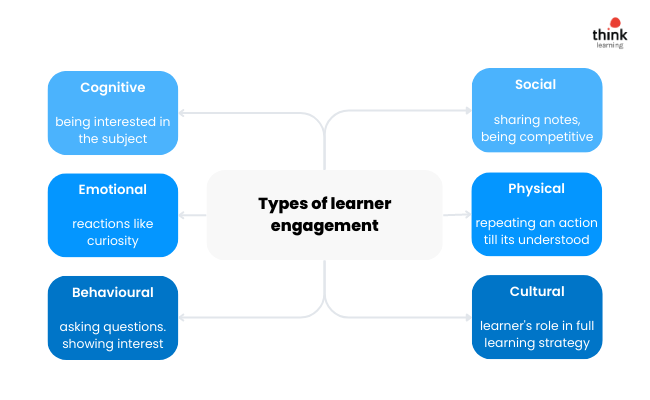
What is learner engagement in the workplace? We define learner engagement plus why you should harness it.
When you’re upskilling or training your employees, you want them to feel invested.
But sometimes, training (compliance in particular) can feel like a tick box exercise.
The truth is, engaging your employees fully in their learning stands to benefit you and them.
In this blog, we’ll look at:
- What learner engagement is
- What an engaged employee looks like
- Different types of learner engagement
- The benefits of high learner engagement
- The challenges of achieving high learner engagement
Let’s get stuck in.
📈 Pro Tip
Want to learn how to increase your learner engagement? Check out this quick and handy guide (download-free!) to improving your employee learner engagement.
What is learner engagement?
Learner engagement is a measure that highlights the level of a learner’s participation. It looks at different types of learner engagement and quantifies how engaged an employee is in their training.
Put simply, learner engagement measures how successful a learning experience is.
Related: How to improve your learning experiences
What does an engaged learner look like?
An engaged learner will tend to have some easy-to-spot qualities that will show. These qualities might not be ones you see day-to-day.
Generally an engaged learner will be:
- Keen to participate
- Get tasks done on, or ahead of, time
- Motivated and putting in effort
- Asking questions and doing further work
- Inspired
- Encouraging other learners
An engaged learner can often carry on this enthusiasm to the rest of their work, meaning better results for you and a more content employee.
Encouraging engaged employees means training is done on time, results are excellent, there’s participation in discussions and more.
📈 Pro Tip
Want to achieve all this? We show you how in our quick guide to upping learner engagement.
13 easy ways to increase learner engagement
6 types of learner engagement
It’s generally thought that there are six types of learner engagement: cognitive, emotional, behavioural, social, physical and cultural.
Finding the right balance between each is key to creating a fully optimised course of learning content.
Related: How to increase learner engagement
You might want to consider blended learning too when it comes to creating learning content, where you mix online and face-to-face learning.
Let’s investigate the 6 types of learner engagement:

- Behavioural learner engagement
- Cognitive learner engagement
- Emotional learner engagement
- Social learner engagement
- Physical learner engagement
- Cultural learner engagement
Behavioural engagement
Put simply, behavioural engagement highlights action and effort.
You could categorise things in the list below as behavioural engagement:
- Paying attention
- Asking questions
- Seeking help
Cognitive engagement
Cognitive learner engagement simply shows that your learners are interested in the course matter.
Cognitively engaged students to go above and beyond the requirements because they’re enjoying the training or being challenged.
Emotional engagement
Affective or emotional engagement shows any emotional reaction to tasks.
The greater the student’s interest level, the higher their enjoyment. And this reaches out to other factors too like curiosity, sense of belonging, positive value and more.
Physical engagement
Sometimes the trick to learning something is to do it for yourself. Of course, this doesn’t apply to everything.
But, for example, if you work in healthcare, then you might have to practice taking blood as part of your training.
By doing it, you start to connect the dots and create a repeatable, physical formula.
Cultural engagement
Cultural learning engagement is all about how your learning and development culture promotes learning within your organisation and how your training reflects it.
For example, you might have a company practice of shouting out employees that attend a particular course. Feeling fully integrated within your company, through learning, is key to driving engagement and increasing learning retention.
Social engagement
With the rise of modern technology and social media, we believe the fourth principle to learner engagement is social engagement.
That’s enjoying sharing notes online, congratulating, or rallying colleagues through online debate, showing a competitive spirit.
All of these can show highly engaged employees. And what’s even better is that you can encourage this principle with the right tools in place.
We use Totara’s basecode to provide organisations with bespoke learning and talent platforms. One flavour they offer is their Engage platform. This is a specific social and engagement platform that can help you create conversations around your learning content.
From sharing tips and tricks relating to your course content, to sharing quizzes or asking questions, the Engage function unlocks the door to the fourth principle: social learning.
Learn more about Engage here
Benefits of high learner engagement
The benefits of learner engagement feel a little obvious, but let’s go through them anyway.
There are two sides to it; the impact on your employees as well as the impact to your workplace.
The importance of learner engagement for learners
A learner’s level of engagement highlights their commitment to upskilling and developing their knowledge and skills.
But what are the tangible benefits?
Lower dropout rates
No matter if training is compulsory, it can be a challenge to get employees to even complete training.
When it comes to compliance, you need to ensure they’re completing these essential tasks.
With good learner engagement, you’ll find yourself chasing less and that employees are less likely to stop halfway through courses.
Higher knowledge retention
Learners who aren’t engaged might still be completing their training, but they’re likely not carrying it with them outside of the classroom.
Engaged learners are more physically involved in their learning and it shows. With high engagement, you can stand to see better knowledge take up and retention.
Improved learner performance
Better knowledge and skills can only be a good thing. Organisations that offer opportunities to develop stand to see a continually improving workforce.
Low engagement teams are 14% to 18% less productive
But, given disengaged learners are less likely to retain their new knowledge, they’re also by consequence less likely to be able to apply it to their job.
More productive employees are going to see better job performance which puts them in good stead of promotions, pay rises and general career development.
The importance of learner engagement for employees
It’s not just employees who stand to see benefits. High levels of learner engagement are great for workplaces too.
Improve learner performance
Engaged learners are motivated learners. They’re keen to learn, develop and perform well.
The skills they learn through learning content makes them more adept at their job, meaning better work performances.
Build a culture of learning
Engaged employees help you to establish a learning culture. And a good course is going to get good feedback and recommendations, meaning you’ll get more staff asking to learn, or engaging more in their training.
Establish better working relationships
Social relationships in the workplace are important. And learning can help foster them. Just think first about all the different people who might sit together on a particular course. That’s new relationships being established across teams. But it also helps deepen previous relationships too.
Especially if you use a tool like Engage to provide a space for social discussion, quizzes and questions.
Encourage personal development
Investing in your people is a worthwhile endeavour. Not just because it’ll improve work performance. It can also improve learning transfer across teams and help reduce employee turnover.
More engaged employees stick around for longer and that’s very good news for your bottom line.
Challenges to achieving high learner engagement
There are several obstacles in the way when it comes to achieving high learner engagement.
We have these down to:
- A lack of learning time
- Poor learning tools
- Negative mindset
- Previous experiences
Let’s go through each in a little more detail.
A lack of learning time
Your employees are busy. They’re managing full days of work and are easily distracted by ringing phones, urgent tasks and whatever else crops up.
This can leave learners disengaged and lacking time to properly dedicate to their development.
When they do engage with learning materials, they might try to skip some of it, or rush through it.
Solve this by allocating set time, away from the hubbub of work, to dedicate to learning. You can also create short courses that can fit more easily within the working day.
🚀 Pro Tip
We worked with West College Scotland who have used our LMS to create a filter on courses based on time taken to complete. This allows even the most time-strapped employee to make time for learning.
Learn more about our LMS
Poor learning tools
If you want your employees to get the most of their learning, then it’s best to consider investing in an LMS.
Related: What is an LMS and what are the benefits?
A learning management system can help you centralise all of your learning and talent data and information.
It removes the admin work from a lot of L&D processes and allows you to get better data on where your learners are up to.
⚡️ Pro Tip
We’re a leading partner of Totara and we use their codebase to create a totally unique learning and talent platform that is made-to-order by our customers.
Learn more about our LMS
Negative mindset
Not everyone is going to take to learning. They might have had poor experiences previously that mean they are simply past the point of learning anything new.
Some people are also simply just resistant to learning and training, and these tend to be disengaged from the get-go.
The trick around this is to show the value of your L&D materials. What will they stand to gain by getting involved?
Previous experiences
Whether it’s a bad teacher, poor quality learning materials or enrolling in poor fit courses, there are a lot of things that can leave a sour taste in your employees’ mouths.
The trick here is to squash any concerns early on. Create an environment where learners can regularly and safely share their feedback.
🚀 Pro Tip
To help solve this issue, we created ThinkLoop, our 360-feedback tool. Customers use it to gather and share feedback on employee performance. But you can also request and share feedback on learning courses too.
Learn more about ThinkLoop
Start creating high learner engagement in your workforce
Think Learning is a leading learning and talent platform that supports customers across sectors get more out of their L&D departments.
From feedback, to process building, learning management system to performance management, we’ve taken the great bits of Totara and added our own plugins and tools to help create a truly bespoke solution.
Book a demo with our team to learn how we could support you to achieve your L&D goals.

